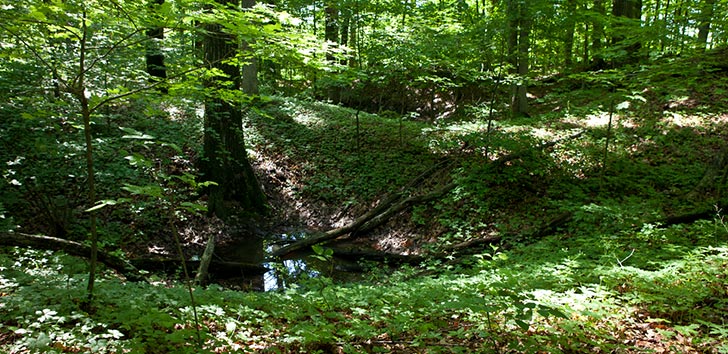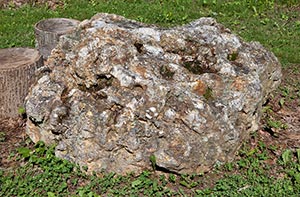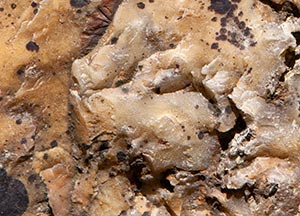

|
| Flint Boulder. |

|
| Close-up of flint boulder. |
Flint Ridge State Memorial, Ohio
For more than 10,000 years, Flint Ridge was one of the most important flint quarries in eastern North America. The flint formed at the bottom of a shallow ocean 300 million years ago. The softer rocks surrounding the flint have washed away, leaving the hard flint exposed near the surface. Prehistoric people came here to quarry the flint, which they crafted into a variety of stone tools. Hundreds of quarry pits and workshops are scattered for miles along the ridge. The beautiful rainbow-colored flint was especially prized by the Hopewell culture that built the nearby Newark Earthworks. Artifacts crafted from Flint Ridge flint may be found throughout eastern North America. In more recent times, local industries quarried the flint for use as grindstones.

Flint Ridge is a chain of long, narrow hills extending from a few miles east of Newark almost to Zanesville, a distance of more than twenty miles. The surface of these hills is underlaid with an irregular layer of flint, which may be only a few inches or several feet in thickness and varies greatly in color and texture. In many places along this ridge the soil has been eroded revealing the underlying flint.
Flint is formed by a geologic process whereby the softer limestones and shales are replaced with much harder silica. Due to its high quartz content, flint polishes beautifully and exceptional pieces of jewelry can be made from it. The 106th General Assembly designated flint as Ohio's official gem stone in 1965 because of its occurrence in several parts of Ohio, particularly Flint Ridge, and because of its importance as a semi-precious gem stone.
Flint is both hard and brittle and thus can be broken into pieces that have razor sharp edges. For this reason Indians as long as 9000 years ago traveled to this ridge to secure the rock for making projectile points, knives, and scrapers. The area is now covered with hundreds of shallow pits from which flint has been quarried through the ages; several are visible along the trails. The pre-historic Indians broke off chunks of flint with stone mauls or pried them out of the pits with wooden poles. They broke the chunks into usable pieces with hammerstones, and then proceeded to chip the flint for various purposes.